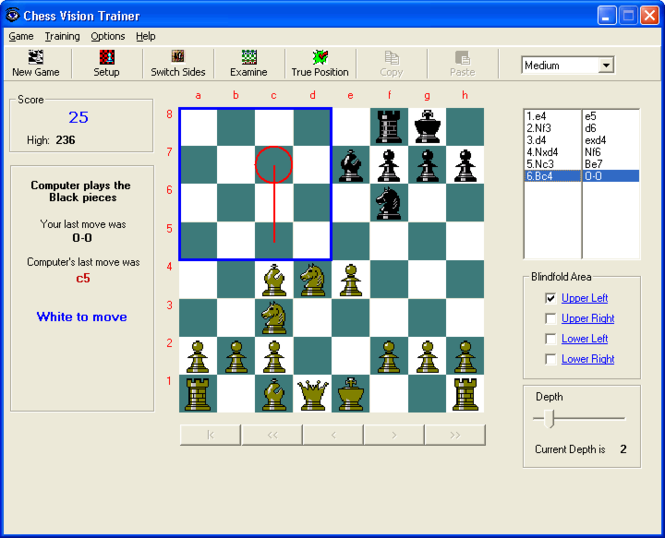 Chess Vision Trainer 3.0
Chess Vision Trainer 3.0
Chess Vision Trainer is a chess training system to improve your visualization and move calculation skills in Chess. You are always forced to look ahead of the chess position you see on the board.
Last update
23 Jun. 2004
Licence
Free to try |
$29.95
OS Support
Windows
Downloads
Total: 3,668 | Last week: 0
Ranking
#330 in
Strategy
Publisher
Chess Technologies
Screenshots of Chess Vision Trainer
Chess Vision Trainer Publisher's Description
Chess Vision Trainer is a chess training system to improve your visualization and move calculation skills in Chess. Visualization and calculation plays a major role in chess. These are the skills that separates the masters from the amateurs.
When Alekhine was asked "How many moves do you see ahead?" his answer was "Just one move deeper than my opponent!".
The built-in chess playing engine is your training partner. The position displayed on the chess board is not the true position but the position a certain number of half-moves prior to the true position. You do not decide the moves based on the displayed position but based on the true position (which you do not see but you're trying to visualize). This means that you are always forced to look ahead of the chess position you see on the board.
Then, there is the concept of 'Blindfold Areas'. Blindfold Areas are quadrants of the chess board and these are areas where the pieces are invisible. One of the intentions of this concept is to solve the problem of 'blind spots'. Using the concept of Blindfold Areas will also help you to develop chess board memory. This idea of dividing the chess board into quadrants for the purpose of visualization is derived from Buckley's suggestion in his book Practical Chess Analysis.
The combination of these training exercises will improve your visualization and move calculation skills.
When Alekhine was asked "How many moves do you see ahead?" his answer was "Just one move deeper than my opponent!".
The built-in chess playing engine is your training partner. The position displayed on the chess board is not the true position but the position a certain number of half-moves prior to the true position. You do not decide the moves based on the displayed position but based on the true position (which you do not see but you're trying to visualize). This means that you are always forced to look ahead of the chess position you see on the board.
Then, there is the concept of 'Blindfold Areas'. Blindfold Areas are quadrants of the chess board and these are areas where the pieces are invisible. One of the intentions of this concept is to solve the problem of 'blind spots'. Using the concept of Blindfold Areas will also help you to develop chess board memory. This idea of dividing the chess board into quadrants for the purpose of visualization is derived from Buckley's suggestion in his book Practical Chess Analysis.
The combination of these training exercises will improve your visualization and move calculation skills.
Look for Similar Items by Category
Feedback
- If you need help or have a question, contact us
- Would you like to update this product info?
- Is there any feedback you would like to provide? Click here
Popular Downloads
-
 Kundli
4.5
Kundli
4.5
-
 Macromedia Flash 8
8.0
Macromedia Flash 8
8.0
-
 Grand Auto Adventure
1.0
Grand Auto Adventure
1.0
-
 Cool Edit Pro
2.1.3097.0
Cool Edit Pro
2.1.3097.0
-
 Grand Theft Auto: Vice City
1.0
Grand Theft Auto: Vice City
1.0
-
 Cheat Engine
6.8.1
Cheat Engine
6.8.1
-
 Hill Climb Racing
1.0
Hill Climb Racing
1.0
-
 Zuma Deluxe
1.0
Zuma Deluxe
1.0
-
 Vector on PC
1.0
Vector on PC
1.0
-
 Ulead Video Studio Plus
11
Ulead Video Studio Plus
11
-
 Tom VPN
2.2.8
Tom VPN
2.2.8
-
 Grand Theft Auto IV Patch...
1.0.1.0
Grand Theft Auto IV Patch...
1.0.1.0
-
 Minecraft
1.10.2
Minecraft
1.10.2
-
 AtomTime Pro
3.1d
AtomTime Pro
3.1d
-
 Netcut
2.1.4
Netcut
2.1.4
-
 Windows XP Service Pack 3
Build...
Windows XP Service Pack 3
Build...
- Bluetooth Device (RFCOMM Protocol... 5.1.2600.2180
-
 Microsoft Office 2010
Service...
Microsoft Office 2010
Service...
-
 Euro Truck Simulator
1.3b
Euro Truck Simulator
1.3b
-
 Age of Empires
1.0
Age of Empires
1.0


